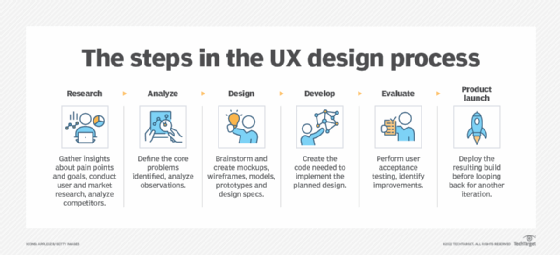cross-platform mobile development
What is cross-platform mobile development?
Cross-platform mobile development is an approach to developing software applications that are compatible with multiple mobile operating systems (OSes) or platforms. These apps are platform-agnostic, meaning they can be used regardless of the OS powering the mobile device.
The need for cross-platform mobile development
Originally, the complexity of mobile app development was compounded by the difficulty of building out a back end that worked across multiple platforms. Although it was time-consuming and expensive, it was often easier to build native applications for each mobile OS. The problem was that the code built for one operating system could not be repurposed for another OS.
Cross-platform development provides a solution to those challenges. With a cross-platform app, some or even all of the source code can be shared across platforms, such as Android and iOS. As a result, developers need to code mobile assets only once. These assets will work seamlessly on all platforms so they don't have to be recoded for each individual platform. Cross-platform development is different from native development, where a mobile app is created to run only on a specific mobile OS.

Native vs. cross-platform development
Native applications are loyal (or native) to a particular OS. Thus, native apps created for Android devices will not work on iOS devices, and vice versa. For the app to run on other platforms, developers must create multiple versions, which requires additional coding effort. This effort adds to development time as well as costs. In addition to accommodating a particular OS, native apps are coded in a particular programming language. Often, the language is Objective-C or Swift for iOS, and Java, C or C++ for Android.
These specifics can be disadvantages in dynamic development environments where language flexibility and speed are essential. In such situations, cross-platform app development may be a better choice since the approach results in a single-code application that will work on every platform right from the outset.
Even though native apps have several disadvantages, they do have some benefits as well, including the following:
- More reliable performance on the intended mobile OS.
- Can fully use the features and capabilities of the device.
- More responsive.
- Can have a more intuitive interface.
- Often deliver a better user experience (UX).

Benefits of cross-platform mobile development
Cross-platform apps have shareable code that can be reused across multiple platforms. A single codebase speeds up development and cuts development costs, particularly for repetitive tasks like data serialization and API calls. Faster development usually translates to faster time to market.
Adopting the cross-platform approach enables project managers to use their development resources more effectively since they don't have to assign separate resources for developing apps for different platforms. Also, fewer lines of code means there are fewer chances of bugs and security errors, reducing the time and effort required for code testing and maintenance.
Another advantage is that in many cases, developers need to only know standard languages. Development tools and frameworks are available to do most of the heavy lifting. Further, cross-platform apps have a wider reach since they can satisfy the needs of audiences using different OSes and devices.
Drawbacks of cross-platform mobile development
Performance glitches are the most common issue with cross-platform apps. Many such apps have limited functionality since they cannot support many native-only functions of mobile devices, such as advanced graphics. Poor design is another common problem, resulting in poor UX.
That said, improvements to development technologies and frameworks are helping to overcome these issues and create cross-platform apps that have the following characteristics:
- Flexible.
- Adaptable.
- Stable.
- High performing.
- Highly functional.
- Able to deliver good UX.
Popular cross-platform development frameworks
Cross-platform app developers can choose from many mobile app development platforms, each with its own capabilities and benefits. Among the most popular frameworks are the following:
Xamarin. Launched in 2011, Xamarin is an Open Source framework for developing cross-platform and hybrid apps that can work seamlessly on any mobile platform, including Android and iOS. Xamarin uses C# programming and Microsoft's .NET framework. It provides its own integrated development environment (IDE), as well as numerous software development kits (SDKs). The platform was once independent but later acquired by Microsoft. Today, it is available under the MIT License as part of Visual Studio IDE and source code editor.
Flutter. Like Xamarin, Flutter is an open source cross-platform framework. Created by Google, Flutter uses the Dart programming language. It is suitable for building many kinds of cross-platform apps that look native on multiple mobile platforms, especially the following:
- Minimum viable products (MVP).
- Apps that may put a heavy load on the device CPU or GPU.
- Apps that need to share UI components while looking as close to native as possible.
Flutter also incorporates platform channel technology that enables developers to create platform-specific code. Additionally, its hot reload feature allows them to make code changes and view them instantly.
React Native. Introduced by Facebook in 2015, React Native is suitable for building both hybrid and cross-platform apps. It is based on the React JavaScript library and supports multiple languages, including Java, Swift and C. Some of the benefits of this framework are the following:
- It can render a native-like interface.
- Code is reusable.
- It provides numerous ready-to-apply features.
- It converts the source code into native elements to enhance UX.
- It's easy to use.
Ionic. Ionic provides a simple syntax and a library of HTML, CSS and JavaScript components to develop interactive cross-platform apps. The framework features hardware-accelerated transitions and touch-optimized gestures to improve app speed and performance. Its single shared codebase enables developers to create flexible UIs for all major OSes. Developers can also choose eye-pleasing themes, form controls, add inline overlays and much more.
Sencha. Sencha is a JavaScript grid to build data-intensive cross-platform applications for both web and mobile. It is based on modern web technologies, such as ES6, HTML5, JavaScript and CSS, and provides more than 140 UI components to quickly build apps for mobile devices.
Learn how to create a mobile app for a small business and explore the benefits of mobile app A/B testing. See the differences between mobile websites vs. mobile apps and explore 10 best practices to make a mobile-friendly website.







